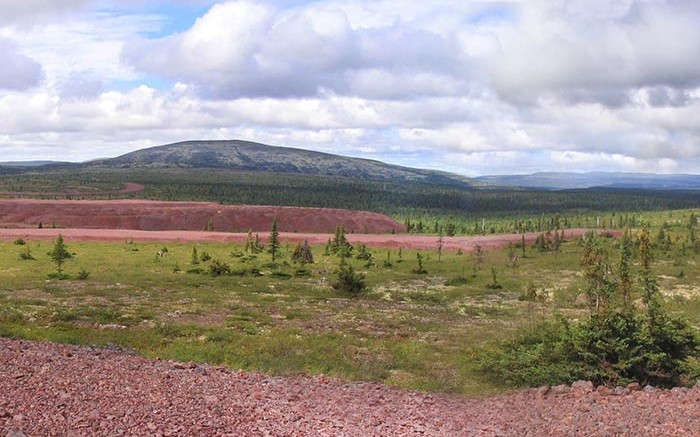Tata Steel Minerals Canada (TSMC) acquired a 51% stake in Labrador Iron Mines’ (TSX: LIM) Howse iron ore deposit in Labrador for $30-million cash in 2013.
Under the joint-venture agreement, Labrador Iron Mines also committed to spend $5 million exploring Howse, and made good on that promise late last year.
TSMC — a subsidiary of India’s Tata Steel group — was also awarded the right to increase its stake in the Howse joint-venture to 70% by spending $23.5 million, after which both companies would contribute to development costs on a pro rata basis.
The deposit is 25 km north of Labrador Iron Mines’ James mine and Silver Yards processing facility, and next to TSMC’s Timmins Area mines and processing plant.
It has been a valuable asset for both partners.
But the severe downturn in the iron ore industry has backed Labrador Iron Mines into a corner. The company halted all mining operations in the last nine months of 2014, as the iron ore price plunged by nearly half last year to US$66 per tonne.
By the end of 2014, Labrador Iron Mines had a working capital deficit of $62.2 million, compared to a $8.7-million working capital deficit as of March 31.
Since the beginning of 2015, the price of 62% Fe has fallen even further to US$50 per tonne by the end of March, and in early April the company announced that it had started a court-supervised restructuring process under the Companies’ Creditors Arrangement Act. It will also sell its 49% stake in the Howse deposit to TSMC for $5 million.
The sale price underscores just how far the fortunes of iron ore producers and developers have fallen in the last couple of years.
“While acquiring Labrador Iron Mines’ 49% of Howse puts TSMC in absolute control of developing the deposit, the acquisition price is a reminder of the depressed valuations in the iron ore industry,” Jay Turner, a mining analyst at Pope & Co. in Toronto, commented in a research note to clients.
For its part, Labrador Iron Mines says the $5 million price tag “is a fair consideration in the current market circumstances, and that this transaction was the best available way to monetize a non-core asset.”
LIM management said in a press release on April 2 that it remains “confident” that, with its debts and key operating contracts restructured, the company could “preserve its key assets, including the flagship Houston project — pending a recovery of iron ore — and secure the necessary development financing to resume operations in a profitable and responsible fashion for the benefit of all stakeholders and local communities.”
Once market conditions improve, the Houston project — 20 km from the company’s Silver Yards facility — is expected to produce up to 3 million tonnes per year of salable product, over an initial mine life of eight to 10 years.
The junior is the first to admit, however, that it must bring down the costs of its Canadian iron ore production if it hopes to compete globally with the rest of the world.
Labrador Iron Mines blames much of the price deterioration in the iron ore industry to excess supply from large Australian producers feeding the Chinese market.
In a January 2015 research report, Jessica Fung of BMO Capital Markets, estimated that Australia and Brazil will substantially add to global iron ore supply by 2019.
“Iron ore supply growth continues to be the bearer of bad news for iron ore prices, given potentially weaker demand from the steel sector,” she writes. “By 2019 BMO Research forecasts an incremental 154 million tonnes per annum of iron ore supply from Australia, and 149 million tonnes per annum from Brazil. This represents nearly 20% of current global supply.”
Since 2006, she points out, Vale (NYSE: VALE), Rio Tinto (NYSE: RTP; LSE: RIO), BHP Billiton (NYSE: BHP; LSE: BLT), Anglo American (US-OTC: AAUKY; LSE: AAL)/Kumba and Fortescue Metals Group have altogether spent almost US$150 billion on their iron ore operations and projects, and by 2020, their iron ore output could double to 1.2 billion tonnes annually.
She notes that the largest iron ore expansions are happening at the lowest end of the cost curve, and that “the iron ore majors can afford to expand even at current prices, but price support for the industry also declines dramatically.”
With expansion of supply putting downward pressure on prices, “sufficient supply cuts must come from China, the highest-cost producer,” she writes.
“However, though BMO Research estimates 60 million tonnes per annum of capacity has already come offline in China, reaching the 170 million tonnes per annum needed is a daunting expectation,” she continues. “If this occurs more slowly than expected, iron ore prices could easily fall below US$60 per tonne for a prolonged period.”
Moreover, she says, “weaker producer currencies do not help when iron ore prices decline by 50%.”


Be the first to comment on "Tata Steel buys LIM’s 49% stake in Howse deposit"